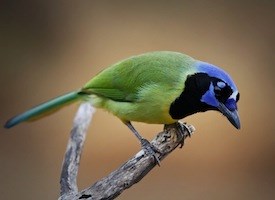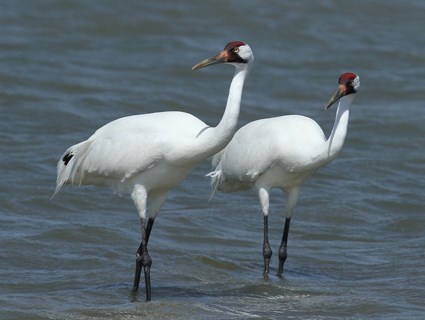Western Gulf coastal prairies are subtropical grasslands that were formerly widespread along the coastal plains of Texas and Lousiana. Bluestem and Indian grasses, common components of tall grass prairies to the north, also grow here. Near the coast and on wetter locations the coastal prairies often merge with freshwater, brackish, and salt marshes. Drier soils host cactus, mesquite, Texas persimmon, and prickly ash. Hurricanes and lightning-induced fires maintain these prairies where herds of bison used to graze. Groves of Texas palms (Sabal texana) occur in the lower Rio Grande valley because the river serves as a fire break that protects this non-fire adapted species. Palm groves grew as far as 50 miles inland during the 19th century, but now there are only 100 acres left, most notably in the Sabal Palm Sanctuary located in Cameron County, Texas. Coastal prairies have also become rare–less than 1% of these remaining unique grasslands are considered pristine. Most have been converted to agriculture.
Location of coastal prairies. This environment was likely more widespread during Ice Ages when dry land extended into the Gulf of Mexico for 50 miles.
A grove of Texas palms. Paradoxically, this environment may have been more widespread during Ice Ages.

Coastal prairie adjacent to a salt marsh in the Aransas National Wildlife refuge.
Coastal prairies support 1 of the 2 remaining populations of whooping cranes.
Palm groves and coastal prairies were likely much more widespread during Ice Ages of the Pleistocene. Glacial advance caused the Gulf of Mexico to recede, resulting in a larger region of dry land where both environments could expand. The prairies served as a corridor that facilitated the movement of western and South American flora and fauna into southeastern North America. Prairie chickens, upland sandpipers, and 13-lined ground squirrels are some western species that lived in the south during the Pleistocene. Ground sloths, glyptodonts, pampatheres (a type of giant armadillo), and mixotoxodons (a large primitive ungulate) used the corridor to advance from South America to what today are the southern United States. The coastal grasslands supported great herds of grazers including mammoths, bison, horse, and giant tortoises. These in turn attracted large predators such as lions, scimitar-toothed cats, and dire wolves.
Paradoxically, this region may have been warmer during the coldest stages of Ice Ages. Glacial meltwater periodically flushed into the North Atlantic, shutting down the Gulf Stream (the tropically heated water that flows into the North Atlantic and keeps climate mild). This caused average annual temperatures in the upper and middle parts of North America to plummet. So this tropically heated water stayed in the Gulf of Mexico, making average annual temperatures in this region warmer than modern day temperatures. The geographical location of the transition between the colder region of the continent and the warmer region may have been abrupt, perhaps explaining why species with northern affinities are often found associated with warm climate species in so many Pleistocene-aged fossil sites. This transition zone likely shifted frequently, on a decadal or even annual basis. Conversely, during interstadials when the Gulf Stream restarted, the middle latitudes enjoyed warmer average annual temperatures (but not as warm as those of today), while the region adjacent to the Gulf of Mexico cooled down (perhaps cooler than modern day temperatures). Changes in the composition of flora and fauna lagged behind these sudden climatic changes.
The lower Rio Grande valley is the northern limit of many tropical species found nowhere else in the United States. Bird watchers can find red-crowned parrots, green parakeets, brown jays, green jays, chacalacas, groove-billed anis, Altamira orioles, Aplomado falcons, and common paroques here. These tropical species likely spread across the region during stadials when the climate was warmer, but they experienced range reduction during interstadials.

Red-crowned parrots recently colonized south Texas. Woodpecker-excavated cavities in frost-killed palms provide perfect nesting for them.

Green jay.

Groove-billed anis.


